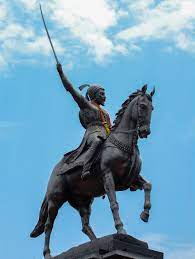
Shivaji Maharaj is one of the great national heroes of India. He created an independent and sovereign state in Maharashtra which was based on justice, welfare of the people and tolerance to all faiths. The aims, objectives and Rajnitee of the Maratha Swaraj under Chhatrapati Shivaji provided a new direction to contemporary politics of India. In course of time, his movement assumed, the form of an all-India struggle; a struggle which was to change the political map of India.
Shivaji Maharaj was born at the Shivneri fort near Junnar in Pune district on 19th February 1630. Shivaji’s mother, Jijabai was the daughter of Lakhuji Jadhavrao of Sindkhed. His father Shahajiraje Bhosale was a prominent sardar in the Deccan. At the time of Shivaji Maharaj’s birth, most of the territory in Maharashtra was under the possession of the Nizamshah of Ahmednagar and the Adilshah of Bijapur. In the coastal belt of Konkan there were two sea powers, the Portuguese and the Siddi. The British and the Dutch who were engaged in expanding their trade also had their factories on the coast. The Mughals, since the period of Emperor Akbar 1 wanted to expand their power in the South. The Mughals launched a campaign to conquer the Nizamshahi Kingdom. The Adilshah of Bijapur allied with the Mughals in this campaign. Shahahajiraje tried to save the Nizamshahi, but he could not withstand the combined might of the Mughals and the Adilshahi. The Nizamshahi kingdom came to an end in A.D. 1636. Thereafter Shahajiraje became a sardar of the Adilshah of Bijapur and was posted in Karnataka. The region comprising Pune, Supe, Indapur and Chakan parganas located between the Bhima and Nira rivers which was vested in Shahajiraje as a jagir was continued by the Adilshah. Shahaijiraje was also assigned a jagir of Banglore. Veermata Jijabai and Shivajiraje, stayed for a few years with Shahajiraje at Banglore till Shivajiraje was twelve years old. Shahajiraje entrusted the administration of the Pune jagir to Shivajiraje and Veermata Jijabai. Shivajiraje grew up amidst the hills and valleys of Pune region under the guidance of his mother Jijabai

Foundation of Swaraj
A number of small spurs run eastward from the sahyadris in the Pune region. The extremely rugged valleys enclosed by these are usually known as the Mavals or Khores each named after stream running through it, or after the principal village. Collectively they are known as the Mavals. The inhabitants of this region who are called the Mavalas, were an extremely hardy people. Shivaji Maharaj started the work of founding the Swaraj in this region which is full of hills and valleys and is not easily accessible. He skillfully utilized the geographical features of Maval region for the purpose of the foundation of the Swaraj. He created a feeling of trust and affection in minds of the people. Many associates, companions and Mavalas joined him in his work of founding Swaraj. The objective of Shivaji Maharaj in founding the Swaraj is clearly expressed in his official seal or Mudra which is in Sanskrit. Through this Mudra, Shivaji Maharaj assured his people that the ‘ever-increasing like the crescent-moon, the kingdom of Shivaji, son of Shahaji, will always seek the welfare of the people’.
The Royal Seal of Shivaji Maharaj
In the medieval period, forts carried much significance. With a firm hold over a fort, one could defend as well as control the surrounding area and could rule the land. In case of an enemy’s invasion, it was possible to protect the people taking shelter in the fort. The forts situated within the jagir of Shivaji Maharaj were not under his control, but were under the control of Adilshah.. Therefore an attempt to capture the forts meant to challenge the Adilshahi power. Shivaji Maharaj decided to acquire the forts that were within his own jagir. He captured the forts of Murumbdev (Rajgad), Torna, Kondhana, Purandar and laid the foundation of the Swaraj. Shivaji Maharaj was steadily but cautiously aiming at extending and consolidating his power. Those sardars who appreciated his aim were brought to his side, but some sardars in the Adilshahi opposed him. It was necessary to bring them under control for the purpose of founding the Swaraj.
Conflict with the Mughals: Shaista Khan’s Invasion
For expansion of the Swaraj, conflict with the Mughals was inevitable. Emperor Aurangzeb appointed Shaista khan, to the viceroyalty of the Deccan, ordering him to invade and annex Shivaji Maharaj’s dominions. Shaista khan left Ahmednagar in February 1660 and arrived in Pune on 10th May 1660. He decided to capture the fort of Chakan to obtain supplies. Though the killedar of the fort of Chakan- Firangoji Narsala offered a strong resistance to Shaista khan’s army, the Mughals captured the fort of Chakan. Shaista khan captured Swaraj’s territories -Pune, Supe. He set up his camp at Lal Mahal in Pune. The Mughal army began to ravage the regions around Pune. Shaista khan adopted the strategy to occupy as much of Shivaji Maharaj’s dominions as possible. Forces were dispatched to invade the Konkan region below the Ghats. Kalyan and Bhiwandi were captured by the Mughal army. Shaista Khan appointed Kartalabkhan on an expedition to the North Konkan. Shivaji Maharaj humbled the Khan in Umbarkhind. Shivaji Maharaj left Netoji Palkar to defend the North Konkan and he himself marched southwards and captured Dabhol, Chiplun, Sangameshwar, Rajapur, Palavani and Shringarpur. Two years had passed but Shaista khan still would not think of leaving Pune. Naturally, this had an adverse effect on the population. With a view to driving Shaista khan out of Pune, Shivaji Maharaj devised a bold plan. On 5th April 1663, Shivaji Maharaj raided Lal Mahal. In this raid, Shaista khan lost his fingers. He left Pune and shifted his camp to Aurangabad. The successful attack on Shaista khan resulted in an immense increase in Shivaji Maharaj’s prestige and fame. It also had an impact on the people and their faith in capabilities of Maharaj was strengthened even further.
The Surat Campaign
In three years time, Shaista Khan had ravaged the territories of the Swaraj. It was necessary to make up this loss. Surat was the richest and most prosperous port of the Mughal Empire on the west coast. Europeans i.e. the British, the Dutch and the French had their factories there. Shivaji Maharaj devised a plan of attack on Surat. The Subhedar of Surat could not put up any resistance to the Marathas. Shivaji Maharaj obtained an enormous wealth from Surat. Surat campaign was a stunning blow to emperor Aurangzeb’s prestige.
Soon after his return from Surat, Shivaji Maharaj embarked upon a vigorous naval program. Shivaji Maharaj had realized the importance of sea forts. Sea forts would provide protection to the navy and keep in check the Siddi of Janjira and the Portuguese. He built Suvarnadurg. In 1664 he commenced the construction of Sindhudurg at Malvan. About the same time he strengthened a fort named Vijaydurg. He also built a fort named Padmadurg on a small island in front of Rajpuri in order to counter the Siddi power.
A Peoples’ King
The Swaraj established by Chhatrapati Shivaji Maharaj comprised of large areas of Nashik, Pune, Satara, Sangli, Kolhapur, Sindhudurg, Ratnagiri, Raigad and Thane districts of Maharashtra. It also included parts of Belgaum, Karwar and Dharwad districts of Karnataka and Jinjee, Vellore and their neighbouring areas in state of Tamil Nadu. He set up an efficient and sound system for the administration of this Swaraj. The administration was divided into eight departments. A minister was appointed at the head of every department. His council of eight ministers was known as the Ashta-Pradhan Mandal. Shivaji Maharaj followed a policy of encouraging agriculture. He paid attention to the welfare of the peasantry. He was also equally concerned about the growth of trade and protection of industries. Thus he turned the Swaraj into a surajya a state which sought the welfare of all. He was a great military commander, an outstanding general and a statesman. He had a clear concept of military organization.
His military organization consisted of infantry, cavalry and navy. Strict discipline, rapid movements, excellent intelligence service and continuous attention to defence marked his military organization. He used to take utmost care to protect his subjects especially at the time of enemy invasions. Shivaji Maharaj was also keen to see to it that the soldiers did not in any way cause any harm to the subjects. He followed a tolerant religious policy. The greatest achievement of Shivaji Maharaj was to inculcate the spirit of independence in his people. By his great deeds and achievements, Shivaji Maharaj created an altogether a new order of things. Shivaji Maharaj’s personality and message are as relevant today as they were in the past.





